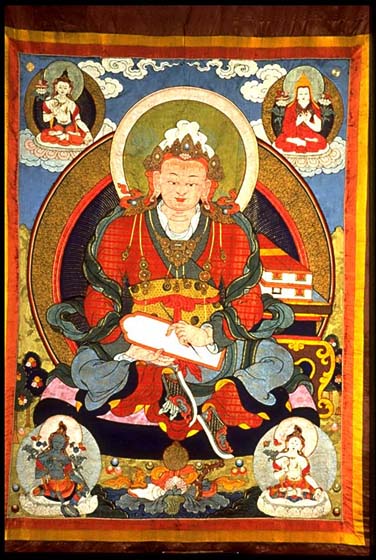Museum of Fine Arts
|
Phagspa (1235-1280) was a Tibetan who played a very important role in the history of Mongolia. In 1244, as a young prince of Sakya, Phagspa, together with his brother Chanadorje, accompanied their uncle Sakya Pandita (1182-1251) as hostages to meet Godan Khan, second son of ÷g^dei. Sakya Pandita surrendered Tibet to the Mongols in order to avoid bloodshed and mass destruction, but he succeeded in converting Godan Khan to Buddhism. Thus began the choyon, or "patron and priest," relationship between the Mongol rulers and the Sakyapa monks of Tibet. After the death of his uncle, Phagspa took his place and became Khubilai Khan's mentor (see Berger, p. 00). He became the State Preceptor of the Yuan dynasty in 1260 and the Imperial Preceptor ten years later, when he was given temporal power over all of Tibet. When Khubilai Khan asked for artists and craftsmen, it was Phagspa who recommended Anige, the phenomenal Newari artist who came to Dadu in 1260 with twenty-four artisans and contributed greatly to the art of the Yuan dynasty. This stately applique Engrave; emphasizes yet another aspect of Phagspa--as the creator of the square-headed Phagspa script (1270), the official script of the Yuan dynasty (see Bosson, p. 00). This script was used on all official documents and seals (see cat. no. 96). Phagspa, in princely costume, sits with left leg bent and right leg pendant on a pile of cushions. His hair is covered with a piece of silk in the manner of the Tibetan kings, and he wears elaborate jewelry. The silk pieces for his costume were carefully chosen. His red robe is woven with gold shou, or longevity, characters, a colorful contrast to the more somber gray scarf, which billows from his elbows in the same style as the silver Amitayus (cat. no. 67). The stack of books on the table behind him indicates his great scholarship, while the stylus and tablet reveal him as the creator of the official script of the Yuan dynasty. The clouds in the sky support two figures enthroned on lotus pedestals. The lama on the left wears a yellow hat and carries the sword and book. Although these attributes of Manjushri usually identify the figure as Tsongkhapa, the founder of the Gelug order, they are also the symbols for Sakya Pandita, Phagspa's uncle. The deity on the right depicts the white form of Manjushri, the god of wisdom. He lowers his right hand in varada mudra, the gift-bestowing gesture while his right hand, raised in vitarka mudra, the gesture of argument, carries a lotus upon which rest the flaming sword and the book of Transcendent Wisdom. Sakya Pandita, Tsongkhapa, as well as Phagspa, are all incarnations of the god of wisdom. The White and Green Taras (the latter of which appears to be more blue than green) are seated beneath Phagspa. A lotus emerges from the lake below, carring the peaceful offering of the five senses: mirror for sight, musical instrument for sound, fruit for taste, sweet curds in a conch for smell, and a knotted silk scarf for touch. Women seamstresses, under the direction of the artist Uran Namsarai, created this wonderful work in the early twentieth century at Urga. |
<< previous image || Mongolian Exhibition || next image >>
